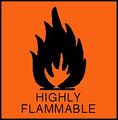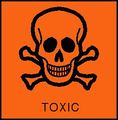Difference between revisions of "MSDS - Methanol"
| Line 6: | Line 6: | ||
| − | |||
| − | |||
<br> | <br> | ||
<br> | <br> | ||
| Line 22: | Line 20: | ||
| − | <table border="2" bordercolor="#AAAAAA" style="background-color: #F9F9F9" width=" | + | <table border="2" bordercolor="#AAAAAA" style="background-color: #F9F9F9" width="900" cellpadding="3" cellspacing="0" bgcolor="#FFFFFF"> |
<tr> | <tr> | ||
<td>Common synonyms</td> | <td>Common synonyms</td> | ||
| − | <td>Methyl alcohol | + | <td> |
| + | *Methyl alcohol | ||
| + | *Wood alcohol | ||
| + | *Meths</td> | ||
</tr> | </tr> | ||
<tr> | <tr> | ||
<td>Formula</td> | <td>Formula</td> | ||
| − | <td> | + | <td>CH<sub>3</sub>OH |
| + | </td> | ||
</tr> | </tr> | ||
<tr> | <tr> | ||
| Line 52: | Line 54: | ||
<td>Principal hazards</td> | <td>Principal hazards</td> | ||
<td> | <td> | ||
| − | *Methanol is toxic. If ingested or inhaledit can cause a wide range of harmful effects, from sickness, heart and | + | *Methanol is toxic. If ingested or inhaledit can cause a wide range of harmful effects, from sickness, heart and liver damage to reproductive harm, blindess or death. |
| − | liver damage to reproductive harm, blindess or death. | ||
*Methanol is often a component in "bootleg" liquor (illegally brewed and distilled alcohol) and there have been numerous cases in the past in which the consumption of such a drink has been fatal. | *Methanol is often a component in "bootleg" liquor (illegally brewed and distilled alcohol) and there have been numerous cases in the past in which the consumption of such a drink has been fatal. | ||
| Line 82: | Line 83: | ||
<tr> | <tr> | ||
<td>Disposal</td> | <td>Disposal</td> | ||
| − | <td>Trace amounts of methanol can be flushed down a sink with a large quantity of water, unless local rules prohibit this. Larger amounts should be collected in a non-chlorinated waste solvent container for disposal.</td> | + | <td> |
| + | *Trace amounts of methanol can be flushed down a sink with a large quantity of water, unless local rules prohibit this. | ||
| + | *Larger amounts should be collected in a non-chlorinated waste solvent container for disposal.</td> | ||
</tr> | </tr> | ||
<tr> | <tr> | ||
<td>Protective equipment</td> | <td>Protective equipment</td> | ||
| − | <td>Safety glasses. If you need gloves, butyl rubber is a suitable material.</td> | + | <td> |
| + | *Safety glasses. | ||
| + | *If you need gloves, butyl rubber is a suitable material.</td> | ||
</tr> | </tr> | ||
<tr> | <tr> | ||
Revision as of 00:47, 24 June 2011
Methanol material data safety sheet. Reproduced with kind permission of Department of Chemistry, Physical and Theoretical Chemistry Laboratory, Oxford University.
Last updated January 8, 2004
| Common synonyms |
|
| Formula | CH3OH |
| Properties |
|
| Principal hazards |
|
| Safe handling |
|
| Emergency |
|
| Disposal |
|
| Protective equipment |
|
| Further information | More extensive safety data |
Bio-rich-time-poor 00:40, 24 June 2011 (BST)

